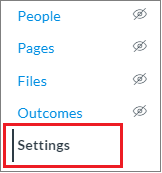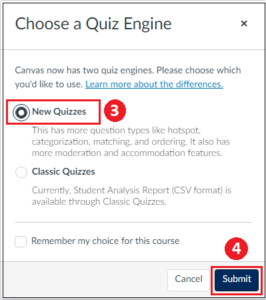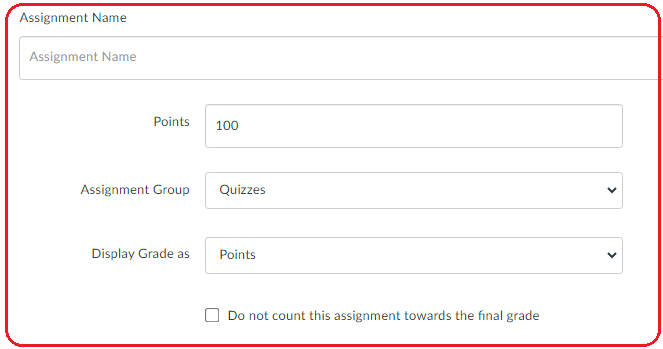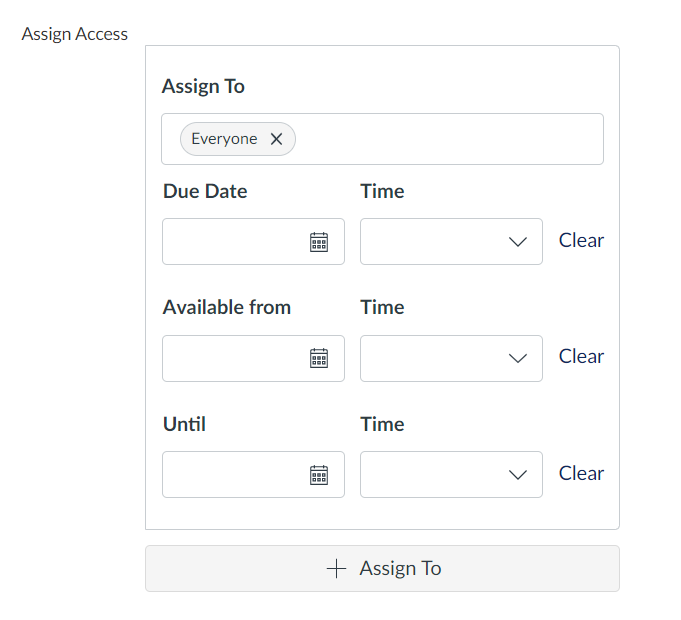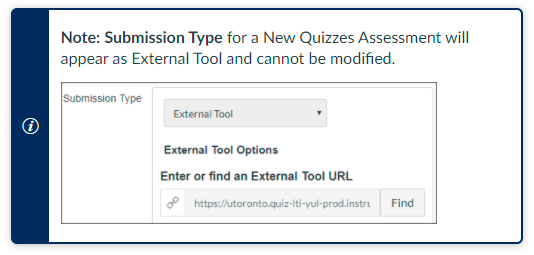Quercus Quizzes

Quizzes in Quercus are assignments that can be used to challenge student understanding and assess comprehension of course material. The quiz tool is used to create and administer online quizzes and surveys. Quizzes can also be used to conduct and moderate exams and assessments, both graded and ungraded.
Quizzes are assignments that can be used to challenge student understanding and assess comprehension of course material through online quizzes and surveys that can be graded and ungraded. Both “New Quizzes” and “Classic” Quizzes tool are available in Quercus.
Instructors can learn more about quiz analytics at Quercus Course Data and Reports.
High-stakes assessments
In general, CTSI does not recommend the use of online tools alone as a simple replacement for high-stakes exams, as this strategy does not meet the University of Toronto policy requirements for exam-taking conditions. Online proctoring tools are available that can be used in conjunction with online Quercus tools such as Classic Quizzes.
Moderate Quiz – add extra time
When using Moderate Quiz to add time to a student’s Quiz attempt there are two options, and it is important to be aware of the method you are using.
Using the “pencil” icon to the right of a student’s name will allow you to grant extra time for any future attempts but WILL NOT add time for an attempt that is currently in-progress. If there you would like to add time to a student’s Quiz that is in-progress, you need to use the “clock” icon that will appear next to the student’s name. This will extend the current attempt but WILL NOT add time for future attempts.
More information on adding time can be found here. For general information on accommodations for Quercus Quizzes, see this page here.
Assessment Reports
Use Classic Quizzes when detailed student reporting is required. Student Analysis Reports are not currently available with New Quizzes.
Student Single Browser Sign-On
Students must open the quiz in only one single browser tab/window when taking quizzes. If students open the quiz in multiple browsers or in more than one tab/window in the same browser, their answers may not be saved or submitted
Duplicating Quiz Content
Copying (or importing) the same content into a course more than once may result in the content that was previously there being overwritten, resulting in lost edits. This can be especially problematic for Quizzes that are overwritten, as questions can take some time to build. If you would like to duplicate a Quiz, export the Quiz as a QTI file, and then Import to the destination course. Refer to Canvas QTI documentation for instructions.
If Students have already submitted to the original Quiz, their responses will not be lost or changed, but may be marked as requiring review if the questions have changed.
When importing a Classic Quiz QTI package to a course, you may encounter a option that cannot be deselected labeled Import assessment content as New Quizzes, forcing import as a New Quiz.
To resolve this :
- Go to your course Settings
- Select the Feature Options tab at the top
- Select the red X icon to the right New Quizzes and select Enable from the drop-down menu
- Import your quiz file and uncheck the Import assessment content as New Quizzes option to import as a Classic Quiz
The Academic Toolbox helps you...
Typical Course Format?
Most tools in the Academic Toolbox can assist in both online and face-to-face courses. Many tools can provide benefits in either synchronous or asynchronous teaching. Some tools have been primarily designed for one format or another (synchronous/asynchronous), however, may be adapted for any format depending on your pedagogical goals.
To learn more about different teaching modalities, please consult our Online Teaching & Learning page, arrange a consultation with a CTSI Teaching Liason, or contact your Divisional support representative.
Where can I get more support?
Related resources / similar tools
How to Get Started
You can view all your quizzes in your course on the Quizzes page. You can also add quizzes and modify quiz settings on the Quizzes page.
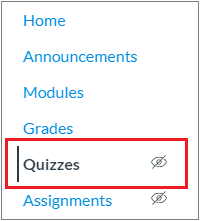
Instructions
-
Classic Quizzes
Use Quercus Classic Quizzes to create a variety of question types to test your students’ learning in an exam format. There are also options to create formative and self-assessments by creating practice quizzes and surveys. There are four types of quizzes available in Quercus:
- Graded Quiz: A column is automatically created in the Gradebook for a graded quiz. After a student takes a graded quiz, certain question types will be automatically graded.
- Practice Quiz: Use practice quiz as a learning tool to help students see how well they understand the course material. Students do not receive a grade for practice quizzes, even though the quiz results display the number of points earned in the quiz.
- Graded Survey: A graded survey allows the instructor to give students points for completing the survey, but it does not allow the survey to be graded for right or wrong answers. Graded surveys have the option to be anonymous.
- Ungraded Surveys: An ungraded survey allows you to get opinions or other information from your students, but students do not receive a grade for their responses. Ungraded surveys can be anonymous.
You can view all your quizzes in your course on the Quizzes page. You can also add quizzes and modify quiz settings on the Quizzes page.

In order to create a new Quiz, click the Add Quiz button.

When you create a quiz, you have a variety of options to choose from within a quiz.
In the Details tab, you can use the Rich Content Editor to add instructions for your quiz. The Office 365 integration displays the OneDrive icon in the Rich Content Editor in Quizzes and allows users to create a hyperlink to OneDrive files directly in the Rich Content Editor. You can also add links, files , and images to the Quiz instructions using the content selector.
Once you have set up the settings for your quiz, click the Questions tab to create the quiz questions and points. You can create individual quiz questions, or find questions in a question bank. You can also create a question group to randomize quiz questions.
Individual questions can be added to a Question Group. Alternatively, you can link the Question Group to a Question Bank.
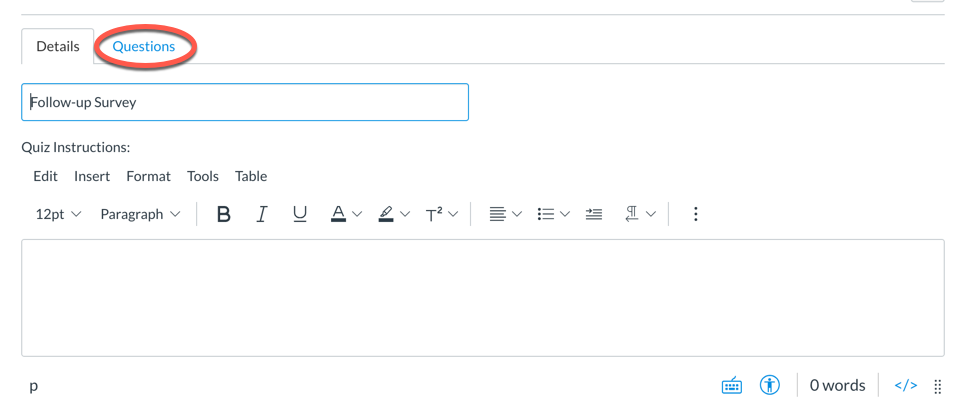
You can view student quiz results within each quiz in your course by viewing the quiz results page or moderating the quiz. When moderating the quiz, you can view the progress of student submissions and view the number of quiz attempts each has taken. You can also grant students extra attempts, grant extra time for timed quizzes, and manually unlock quiz attempts. As a moderator, you cannot remove student submissions.
If you are creating Multiple Choice questions and quizzes, you may find the following CTSI tips sheets helpful: Multiple Choice Question and Quiz Tips and Multiple Choice Quercus Quiz Analysis Reports.
Note about Quercus (Canvas) System Performance:
For optimum course performance in the Quercus (Canvas) interface, quiz statistics will only generate for quizzes with 100 or fewer unique questions or 1,000 total attempts. For instance, a quiz with 200 questions will not generate quiz statistics. However, a quiz with 75 questions will generate quiz statistics until the quiz has reached 1000 attempts. Results greater than these maximum values can be viewed by downloading the Student Analysis report and viewing the CSV file.
-
New Quizzes vs. Classic Quizzes
Please consult the following Canvas resources for the most up to date information:
New Quizzes offers some new features and question types, but does not currently have some of the features of the original Classic Quizzes tool. We recommend using Classic Quizzes unless a feature you require is only available in New Quizzes.
New Quizzes offers some features that are not available in the Classic Quizzes tool. For example, in New Quizzes, you can:
- set a waiting period between quiz attempts for quizzes with multiple attempts
- Moderate a student’s quiz attempt in New Quizzes
- use new questions types, including:
Eventually, Instructure will retire the original Canvas Classic Quizzes tool. At that time, Classic Quizzes will be removed from Quercus and New Quizzes will remain as the only quizzing tool.
Instructors may want to use Classic Quizzes for assessments that require detailed student reports or when copying item banks.
-
Enabling New Quizzes
To enable New Quizzes in your Quercus course:
1. Click on Settings in the Course Navigation menu

2. On the Feature Options tab, click the New Quizzes slider to ON.
The slider will be green when activated.

Create a New Quizzes Assessment
New Quizzes assessments display a solid icon of a rocket [1] while Classic Quizzes assessments display an outline of a rocket [2].

To create a New Quizzes assessment:
-
- In Course Navigation, click the Quizzes link.
- Click the Add Quiz button.
- Click New Quizzes, when prompted to select a Quiz engine.
- Click Submit.
- Edit Assessment Details,including:
- Assignment Name
- Total points possible
- Assignment Group
- How grade is displayed to students, by selecting an option from the Display Grade as menu
- Remove assessment from final grade calculations, if appropriate, by clicking the Do not count this assignment towards the final grade checkbox
- Assign Assessment:
- Use the Assign To feature to select who will be required to take the assessment (can be assigned to Everyone, individual students or sections)
- Use the Due Date and Time fields to select the assessment due date/time.
- Use the Available From and Until fields to select the availability dates/times for the assessment.
- Use the + Assign To button to assign a different due date or availability window to individual students or sections.

- Click Save to save the assessment details.
Note: it is recommended to NOT click Save and Publish until the assessment has been built and its settings defined

-
-
To learn more about New Quizzes and how it compares with the existing Classic Quizzes tool, please see the following documents:
- FAQ: New Quizzes
- Canvas New Quizzes Feature Comparison (updated 2025)
Features Not Yet Available in New Quizzes
Some features that are available in the Classic Quizzes tool are not currently available in New Quizzes. However, they may be added in the future. The main identified feature parity differences in 2025 are:
New Quizzes “Item Bank” vs Classic Quizzes “Question Bank”
The new Item Bank replaces the Question Bank, however the storage of the questions/items also changes. It no longer lives in the course, which affects course copies. Item banks are saved by the user who can share, but it doesn’t get copied into the course, it lives with the user account.
Surveys – workaround
New Quizzes does not have an option to create surveys, either graded and ungraded. However, it is possible to create a New Quizzes assessment with no point value. See the Canvas guide: Zero Point New Quizzes.
Student analysis report – 2025 update
In New Quizzes, a Student Analysis Report is available. To access the Student Analysis report, go to the New Quiz and click on the “Reports” tab. Then, click “Generate” in the “Student Analysis” reports box. Refer to this Canvas Product Blog for more information.
Guides
-
Quizzes
- How do I use the Quizzes Index Page?
- How do I publish or unpublish a quiz as an instructor?
- What quiz types can I create in a course?
- What options can I set in a quiz?
- How do I import quizzes from QTI packages?
- How do I create a quiz with individual questions?
- How do I create a quiz with a question group to randomize quiz questions?
- How do I create a quiz by finding questions in a question bank?
- How do I create a quiz with a question group linked to a question bank?
- How do I create a Multiple Choice quiz question?
- How do I create a True/False quiz question?
- How do I create a Fill-in-the-Blank quiz question?
- How do I create a Fill-in-Multiple-Blanks quiz question?
- How do I create a Multiple Answers quiz question?
- How do I create a Multiple Dropdown quiz question?
- How do I create Likert scale quiz questions?
- How do I create a Matching quiz question?
- How do I create a Numerical Answer quiz question?
- How do I create a Formula quiz question with a single variable?
- How do I create a Simple Formula quiz question?
- How do I create an Essay quiz question?
- How do I create a File Upload quiz question?
- How do I create a Text (no question) quiz question?
- How do I link course content to a quiz question?
- How do I create a question bank in a course?
- How do I bookmark a question bank in a course?
- How do I unbookmark a question bank in a course?
- How do I delete a question bank in a course?
- How do I move multiple questions from one question bank to another?
- How do I move/copy a question from one question bank to another?
- How do I reorder questions or question groups in a quiz?
- How do I import a question bank from one Canvas course to another?
- How can I create a quiz where students only see one question at a time?
- How do I make a quiz available before or after the due date?
- How do I assign a quiz to an individual student?
- How do I assign a quiz to a course section?
- How do I delete a quiz?
- How do I export quiz content from a course?
- How do I copy a quiz to another course?
- How do I send a quiz to another instructor?
- Once I publish a quiz, how do I make additional changes?
- Once I publish a quiz, how do I use the Moderate Quiz page?
- Once I publish a quiz, what kinds of quiz statistics are available?
- Once I publish a quiz, how can I give my students extra attempts?
- Once I publish a timed quiz, how can I give my students extra time?
- How do I manually submit outstanding student quiz submissions?
- How do I view student results in a quiz?
- How do I view a quiz log for a student?
- What options can I use to regrade a quiz in a course?
- How do I regrade a Multiple Choice quiz question?
- How do I regrade a True/False quiz question?
- How do I regrade a Multiple Answers quiz question?
- How do I create a survey in my course?
- How do I view survey results in a course?
- How do I view practice quiz results in a course?
-
New Quizzes
- How do I create a quiz using New Quizzes?
- How do I duplicate a New Quizzes quiz?
- How do I migrate a Canvas quiz to New Quizzes?
- How do I import a quiz from a QTI package in New Quizzes?
- How do I use the Rich Content Editor in New Quizzes?
- How do I create a Categorization question in New Quizzes?
- How do I create an Essay question in New Quizzes?
- How do I create a File Upload question in New Quizzes?
- How do I create a Fill in the Blank question in New Quizzes?
- How do I create a Formula question in New Quizzes?
- How do I create a Hot Spot question in New Quizzes?
- How do I create a Matching question in New Quizzes?
- How do I create a Multiple Answer question in New Quizzes?
- How do I create a Multiple Choice question in New Quizzes?
- How do I create a Numeric question in New Quizzes?
- How do I create an Ordering question in New Quizzes?
- How do I create a True or False question in New Quizzes?
- How do I insert stimulus content in New Quizzes?
- How do I duplicate an individual question in New Quizzes?
- How do I add feedback to a question in New Quizzes?
- How do I reorder questions in New Quizzes?
- How do I edit a quiz in New Quizzes?
- How do I edit the assignment details of a New Quizzes quiz?
- How do I manage settings for a quiz in New Quizzes?
- How do I restrict students from viewing quiz results in New Quizzes?
- How do I preview a quiz in New Quizzes?
- How do I grade a quiz in New Quizzes?
- How do I regrade a quiz question in New Quizzes?
- How do I manage item banks in New Quizzes?
- How do I create an item bank in New Quizzes?
- How do I add content to an item bank in New Quizzes?
- How do I import questions from a QTI package into an item bank in New Quizzes?
- How do I add an item from an item bank to a quiz in New Quizzes?
- How do I edit an item bank item in New Quizzes?
- How do I add all items or a random set from an item bank to a quiz in New Quizzes?
- How do I move or copy a question from one item bank to another in New Quizzes?
- How do I share an item bank in New Quizzes?
- How do I print a quiz in New Quizzes?
- How do I align an outcome to a quiz in New Quizzes?
- How do I align an outcome to a quiz question in New Quizzes?
- How do I view reports for a quiz in New Quizzes?
- How do I use the Moderation page in New Quizzes?
- How do I moderate a student’s quiz attempt in New Quizzes?
- How do I add accommodations for a student in New Quizzes?
- How do I view student quiz results in New Quizzes?
- How do I delete a New Quizzes quiz?
- How do I copy a quiz to another course in New Quizzes?
- How do I send a quiz to another instructor in New Quizzes?
Canvas Instructor Guides
-
-
Providing Supports for Students within New Quizzes
^ The above link provides ways to incorporate student supports within New Quizzes, with the aim to assist our Multilingual Learners. However, just like many other supports designed for English Learners, these strategies are beneficial for all students. While some of these supports can also be used in Classic Quizzes, several of the examples focus on question types available exclusively in New Quizzes.
Last Modified:
5 December, 2025
This work is licensed under a Creative Commons BY-NC-SA 4.0 International License


